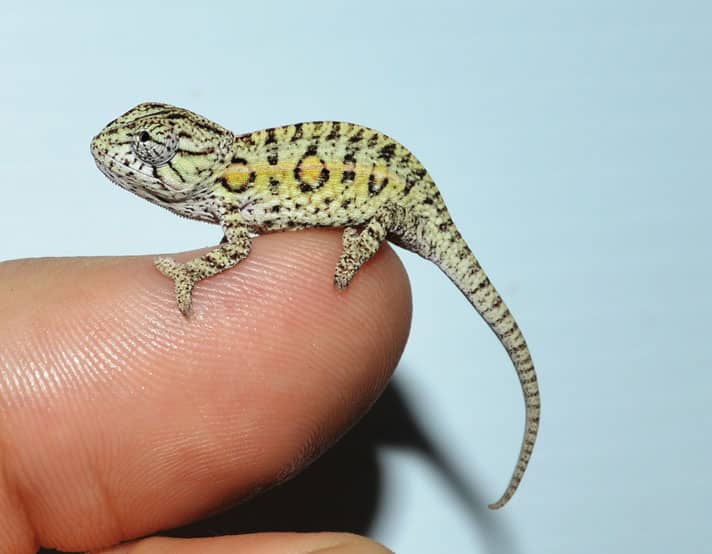Find out why Furcifer lateralis may be the perfect chameleon.
The carpet chameleon (Furcifer lateralis) occupies an interesting space in the reptile-keeping hobby. To me, it is an ideal species for a chameleon keeper. It is one of the most vibrantly colored species of chameleons in the world, remains a very manageable size, is highly prolific, and captive-bred animals are quite hardy.
And yet, even with all of these positive attributes, the carpet chameleon has not caught on in the hobby because it has a somewhat undeserved reputation for being extremely delicate and short lived. In reality, carpet chameleons aren’t any more delicate than the ubiquitous panther chameleon (F. pardalis), as long as they are captive bred.
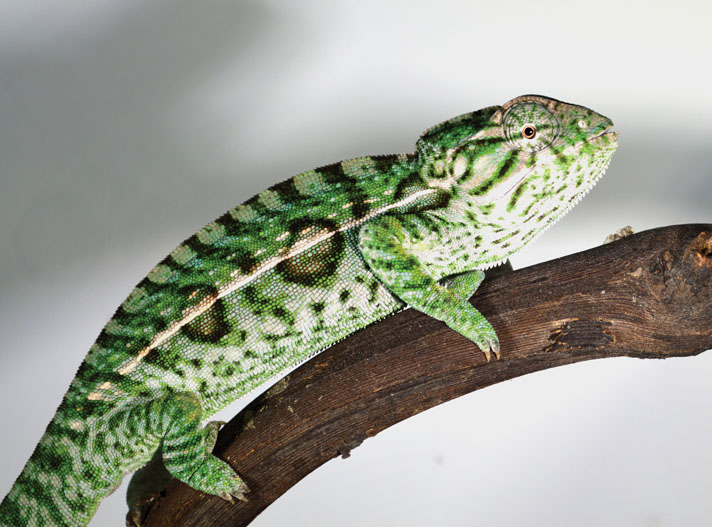
Frank J. Payne
While F. lateralis may not live as long as other chameleons that are available, a healthy, captive-bred specimen can still live two to three years with good care.
I believe the carpet chameleon’s mostly unfair reputation for being delicate or short lived stems from the fact that wild-caught F. lateralis are, indeed, very difficult to keep alive in captivity due to the ordeal of collection and importation. Wild-caught carpet chameleons are imported regularly and carry a cheap price tag, and breeders of this species are few and far between. So, unfortunately, the first experience many keepers of this chameleon have is with delicate, wild-caught animals that often arrive in the U.S. toward the end of their natural life spans.
While F. lateralis may not live as long as other chameleons that are available, a healthy, captive-bred specimen can still live two to three years with good care. This may seem short, but it’s only about a year less than the average lifespan of a panther chameleon.
The carpet chameleon also more than makes up for its shorter lifespan by being highly prolific, reaching sexual maturity at around 6 months of age. This makes F. lateralis an ideal breeding subject for hobbyists who are looking for a fast turnaround time with a limited amount of space, as a carpet chameleon can live out its life in an enclosure a fraction of the size of one a panther chameleon would need.
I really hope this article can increase the species’ popularity, as healthy, captive-bred carpet chameleons can be an ideal first chameleon — or second, or tenth! After reading this article, and especially after viewing the accompanying photos, you’ll understand why I am so passionate about this wonderful little chameleon.
Carpet Chameleon Description and Sex Determination
One of the best things about the carpet chameleon is its smaller size, which makes F. lateralis a great species for apartment dwellers and other hobbyists who have more limited space.
Adult carpets average only 4 inches snout to vent, and about twice that including the tail. There is usually no difference in size between males and females, although I have seen a few wild-caught males that were exceptionally large.
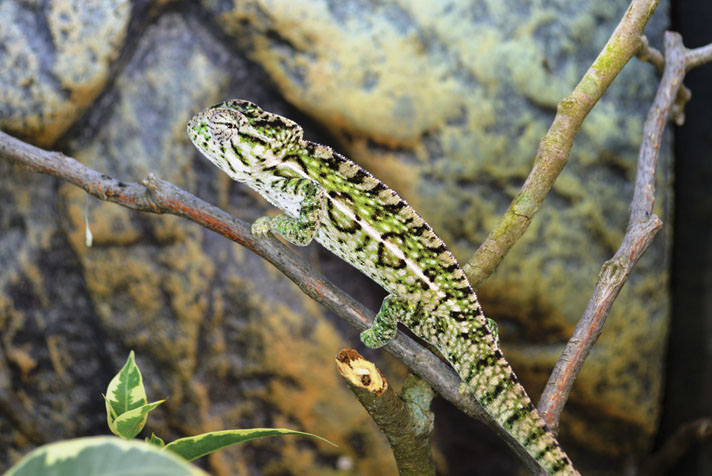
Frank J. Payne
Adult carpets average only 4 inches snout to vent, and about twice that including the tail.
The most obvious difference between the sexes is coloration. Adult males can be beautiful with very nice shades of green and blue, but it’s the females that really put on a fireworks show. The variety and vividness of coloration of female carpet chameleons is almost unmatched in the chameleon world, and they can display greens, reds, blues, yellows, white, black, orange, and even purple. What I love most about their coloration is just how variable it can be, even among clutchmates.
Even without relying on coloration, sex determination of carpet chameleons is fairly straightforward because males, including juveniles, have a noticeably widened tail base due to their hemipenes. With practice, a breeder can see this difference in tail base, even in baby chameleons right out of the egg.
The Best Carpet Chameleon Enclosure
When keeping carpet chameleons indoors, I prefer to use all-glass terrariums such as those made by Zoo Med and Exo Terra. My adults are kept individually in both 18 by 18 by 24-inch-tall and 18 by 18 by 18-inch-tall glass terrariums. All the screen enclosures that are typically recommended for chameleons can also be used successfully, those these will require a stronger basking light and more frequent and prolonged misting sessions to maintain the proper temperature and humidity.
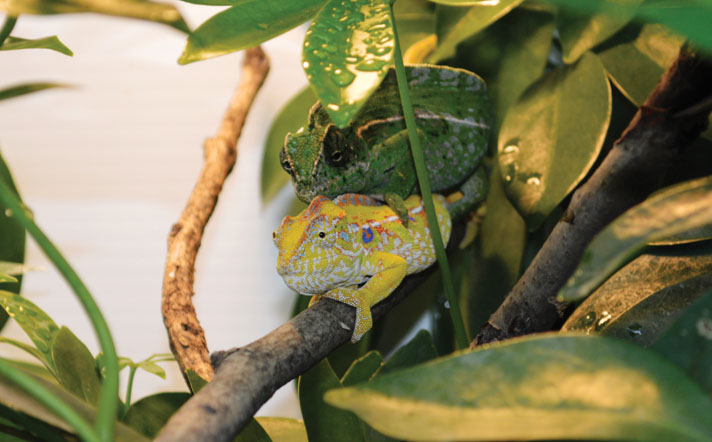
Frank J. Payne
The author prefers to keep F. lateralis in fully planted, naturalistic glass terrariums. The bottom of each terrarium has a drainage layer of pea gravel or clay pellets that’s 1 to 2 inches deep.
I prefer to keep my F. lateralis in fully planted, naturalistic glass terrariums. The bottom of each terrarium has a drainage layer of pea gravel or clay pellets that’s 1 to 2 inches deep. On top of this drainage layer I place a porous fabric that functions as a root and soil barrier. On top of the fabric is a 3-inch soil layer made of a 50/50 mixture of sand and peat moss.
Live plants, such as Ficus benjamina and Scheffelera arboricola, are planted directly into the soil layer. A 1-inch-thick layer of dead leaves on top of the soil completes the bioactive substrate. Some people will add springtails and isopods to the soil as cleaner crews, but in my experience this is uncesseary. These beneficial insects always find their way into the substrate anyway, from the leaves, plants, soil and branches.
Because carpet chameleons are arboreal, their enclosures should include a live, bushy plant (such as the previously mentioned F. benjamina and S. arboricola) that takes up about half of the space inside the terrarium; they will climb on it, hide in it and drink off it. Thin branches of various diameters should be arranged throughout the cage so that the chameleon can perch within a variety of environmental conditions, on branches in the upper parts of the terrarium that are exposed to the basking and UV light, as well as branches toward the middle and bottom that are shaded by leaves. Place branches at a variety of angles: horizontal, diagonal and vertical.
Carpet Chameleon Lighting
Because carpet chameleons are diurnal and helioliphic (sun-loving) animals, bright light of the proper spectrum needs to be provided. T5 high-output fluorescent lighting has become the gold standard for terrarium lighting, and if you are lighting a larger enclosure (24 inches or taller), they are probably your best bet.
LED lighting is becoming more popular for terrariums but does not yet provide the proper UV radiation. A dual fluorescent light fixture works well when placed over a few enclosures of the previously mentioned dimensions. One bulb should be a 6500K bulb, which will provide nice white light and be very beneficial to both plants and chameleons. The other bulb should be a UVB-producing bulb; the T8 bulbs I use for UVB are the Zoo Med 10.0 bulbs, which should be replaced yearly. I also use Arcadia 6.0 T5HO bulbs, which need to be replaced every 18 months.
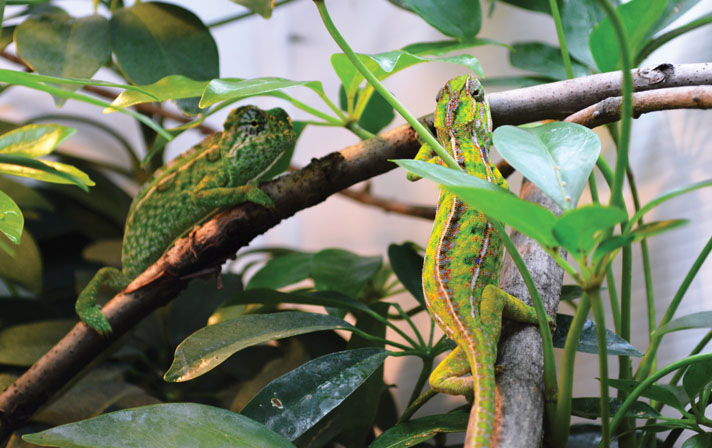
Frank J. Payne
Because carpet chameleons are diurnal and helioliphic (sun-loving) animals, bright light of the proper spectrum needs to be provided.
Linear fluorescent bulbs such as those described are best if you are lighting multiple terrariums, as mentioned. If you are lighting just one terrarium, then a screw-in, compact fluorescent bulb could be an effective option. These are available from various manufacturers and some keepers swear by them, though I, personally, have no experience with them because I only use linear fluorescent bulbs.
Another type of UV-producing bulb that I am using more often is the mercury vapor bulb. These produce a lot of heat, though, so should only be used in larger terrariums, but the amount of light and UV they produce is excellent.
Ideal Carpet Chameleon Temperature Ranges
Carpet chameleons originated in Madagascar, and so pet chameleons require fairly warm temperatures. As when keeping all reptiles, thermal gradients are the key to lasting success, and you want to provide a variety of suitable temperatures from which your chameleon can choose. Furcifer lateralis needs a basking spot that is provided by a light source. My heat light of choice are halogen puck lights. A string of four or five can be purchased for $20 or less. Only use one per enclosure unless they’re being used with a very large terrarium.
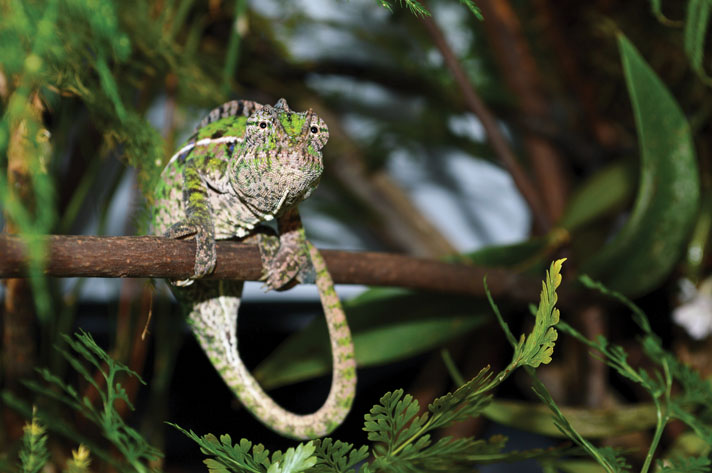
Frank J. Payne
Carpet chameleons originated in Madagascar, and so pet chameleons require fairly warm temperatures.
There are a few things to consider when using puck lights. First, make sure you get the halogen and not the xenon puck lights; the latter often do not work with a timer. Puck lights should be plugged into a dimmer switch, which allows you to very precisely control the amount of heat produced to achieve the desired temperatures. The use of a dimmer also dramatically increases bulb longevity, and a plug-in dimmer can be purchased inexpensively.
If you are using a terrarium that is taller than 24 inches, then a puck light will likely be insufficient. More typical screw-in bulbs in the 40- to 60-watt range may be necessary; I recommend using the halogen flood type of screw-in bulb if needed.
All lights, both heating and fluorescent, should be plugged into a timer. This allows for a predictable light cycle that the chameleons can follow. It also allows you to adjust the time that the lights are on during different seasons. My lights are on for 14 hours during the peak of summer, 10 hours during winter, and 12 hours during fall and spring.
Your heat lights and fluorescent lights should create proper thermal gradients in the terrarium. For carpet chameleons, I try to aim for a localized basking spot of around 90 to 95 degrees Fahrenheit. The topmost part of the terrarium is kept at around 80 to 85 degrees, and it’s 70 to 75 degrees toward the bottom and in shaded regions.
A nighttime drop in temperature is easily accomplished simply by turning off all the lights at night, and my nighttime temperatures are around 70 degrees.
During the winter months, all of these temperatures are maintained at about 5 to 10 degrees cooler.
Carpet Chameleon Misting System
A water bowl is not recommended for carpet chameleons. To provide them with adequate water you will need to mist their terrarium. This can be as easy and inexpensive as using a $1 hand mister or as complex as an automated misting system. Many keepers use hand misters, but I think an automated misting system is one of the best investments you can make when keeping carpet chameleons. The mist they provide is very fine, can be regulated precisely with a timer and it doesn’t disturb the animals. They are available from various manufacturers; I have several MistKing systems in operation, including one that has seen continuous use for 10 years without issue. At the time of this writing I am also starting to use ProMist pumps and am satisfied with them so far.
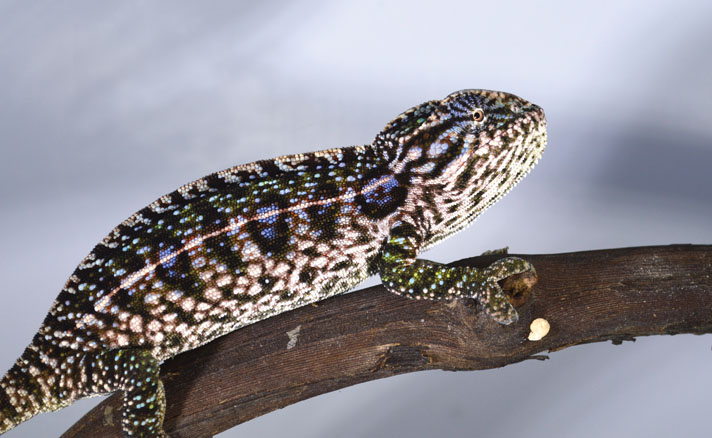
Frank J. Payne
A water bowl is not recommended for carpet chameleons. To provide them with adequate water you will need to mist their terrarium.
My chameleons that are kept in glass terrariums get misted two or three times a day for approximately 30 seconds to one minute each session. However, this is something that needs to be adjusted for every enclosure and keeper. The goal is to thoroughly cover the leaves of the plants and the sides of the terrarium with water droplets and then stop before the soil becomes overly saturated.
It is important not to mist the enclosure again until all the water droplets have evaporated and the topmost layer of the soil/leaf litter has started to dry out. To make sure this happens, proper ventilation must be present in the enclosure, which is easily achieved by making sure the entire lid of the enclosure is screen and that at least one of the sides has some ventilation openings (I prefer not to recommend a proper humidity for this species, as I have never measured it in my terrariums). It may take time and practice to find the proper misting schedule for your own enclosures. Just remember, it’s OK for the terrarium to dry out for most of the day as long as the humidity remains relatively high and the animals have the opportunity to drink daily.
Chameleons will not drink from a water bowl. They receive all their required water by lapping up water droplets that have accumulated on plant leaves and the sides of the terrarium via misting.
Carpet Chameleon Diet and Nutrition
Furcifer lateralis is completely insectivorious, and I provide my animals with as many different types of insects as possible, including, among others, crickets, mealworms, superworms, red runner roaches, green banana roaches, fruit flies and bean beetles.
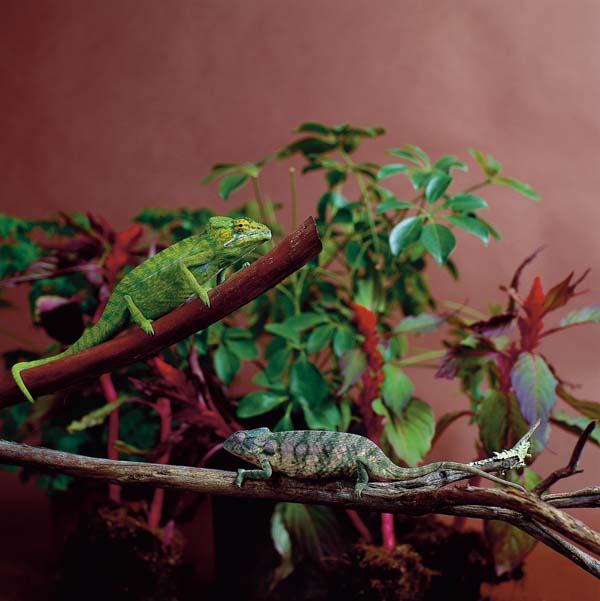
Frank J. Payne
All insect feeders should themselves be fed a healthy gutload to make them more nutritious for your chameleon.
Make sure the insects are appropriately sized, usually about the length of the space between the chameleon’s eyes (longer is OK for mealworms). All insect feeders should themselves be fed a healthy gutload to make them more nutritious for your chameleon. I feed my insects fresh produce only, and my gutloading diet includes apples, sweet potatoes, kale, collard greens, dandelion greens, carrots and peppers.
Carpet chameleons are voracious eaters and should be fed accordingly. Feed juveniles daily, as much as they will eat. Adults can be fed every other day. Plan on six appropriately sized insects per adult animal and up to 12 insects per juvenile per feeding.
Supplementation is a hotly contested topic in the world of chameleon husbandry, and rather than get into the debate here, I’ll just say I have had success dusting all of my feeder insects with Repashy Calcium Plu LoD.
Breeding Carpet Chameleons
Carpet chameleons are prolific breeders that make for a very rewarding breeding project in a short period of time. Both males and females are usually ready to mate for the first time at 6 months old, and sometimes sooner; I once had a male breed at 41/2 months of age!
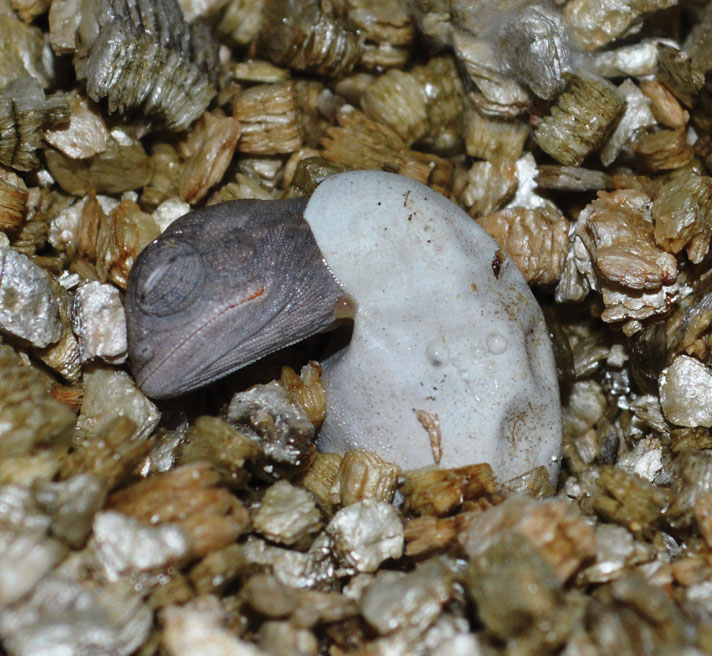
Frank J. Payne
Hatchling carpet chameleon care is identical to that of the adults, except on a smaller scale, plus the fact that hatchlings can be raised together in small groups until sexual maturity.
Mature male carpet chameleons will rarely turn down an opportunity to mate. Females signal their readiness by turning beautiful, soft-pastel shades of greens, pinks, blues and purples. If you suspect a female is ready to mate, place the pair together. If she is receptive, she will remain softly colored and will not react to the male. If the female is not ready to mate, however, she will often turn mostly black, with vibrant reds and blues, while puffing up with her mouth open to repel the male. Unreceptive females should be removed immediately, and you can try placing the pair together again after a few days.
If the female is receptive the male will head bob, and mating usually begins quickly. Copulation usually lasts around 20 to 30 minutes. Sometimes, one mating is all a female will accept before becoming unreceptive and aggressive toward the male. Other times, the pair will mate several days in a row before the female becomes unreceptive. Keep in mind that carpet chameleons can be aggressive and cause real harm to each other when placed together. Because of this, I always separate the pair if I am not able to be present to keep an eye on them.
Carpet Chameleon Eggs and Hatchlings
Egg laying can be the most challenging aspect when breeding F. lateralis. Females are notorious for scattering their eggs instead of burying them. I have found, however, that as long as they are provided with an appropriate egg-laying site at the appropriate time, they will dig and bury their eggs regularly.
In my experience, a female carpet chameleon will be ready to lay her eggs 14 to 35 days after breeding. A day or two before she does, she will usually stop eating. This is when I place her in an egg-laying box, which is a 5-gallon, opaque, plastic storage container with a 20 to 40-watt heat light placed on one side. The inside of the container contains a 6 to 8-inch layer of a 50/50 mixture of sand and peat moss.
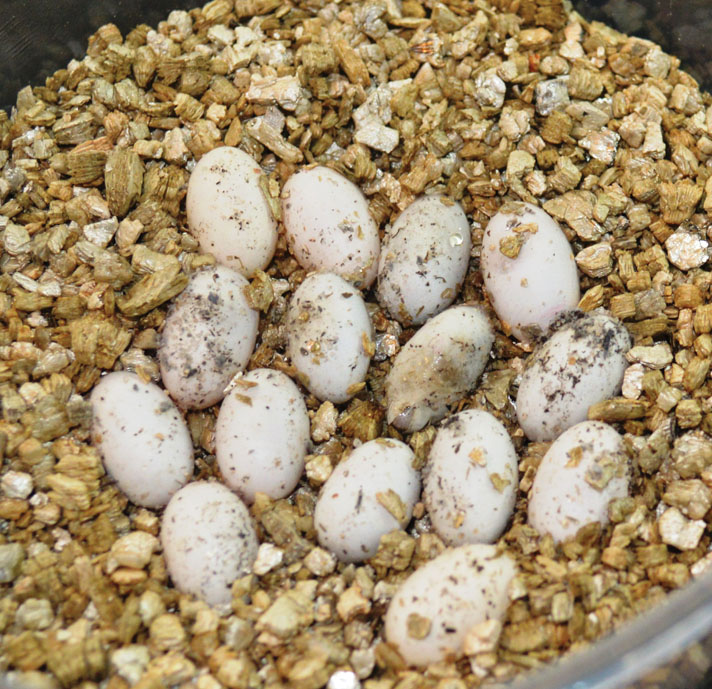
Frank J. Payne
Eggs are incubated in 16-ounce deli cups, with lids (no holes in the lids), containing 30 grams of vermiculite moistened with 20 grams of water.
The key to getting a female carpet chameleon to dig and bury her eggs is to ensure the soil in the egg-laying container is appropriately moist — it should be very wet but without standing water. Whenever one of my females refused to dig, it was because the soil in the egg-laying container was too dry. I leave the female in the egg laying container all day when the lights are on and return her to her terrarium at night. The next morning, I will water her heavily and offer food, and after a drink she goes back into the container. This is repeated until she lays the eggs.
If a female does not bury her eggs and, instead, scatters them on the surface of the soil, there is still a good chance of saving them as long as they are found quickly, before they dessicate.
Clutches from my females usually number between six and 18 eggs. They are incubated in 16-ounce deli cups, with lids (no holes in the lids), containing 30 grams of vermiculite moistened with 20 grams of water. My current method of incubation begins with maintaining the eggs at 72 degrees for 45 days, then lowering the incubation temperature to 60 degrees for a 45-day diapause, after which the eggs are again incubated at 72 degrees for the duration of incubation. Using the diapause method often shortens incubation times, and the eggs also tend to hatch closer to each other, but even with diapause, incubation duration can vary widely. I have experienced incubation times of anywhere from six to 13 months.
Hatchling carpet chameleon care is identical to that of the adults, except on a smaller scale, plus the fact that hatchlings can be raised together in small groups until sexual maturity. Food items for hatchlings may include fruit flies, bean beetles and pinhead crickets. As the babies grow, it is sometimes necessary to separate them based on size because some will grow more quickly than others. Furcifer lateralis babies will grow rapidly with appropriate care and will be ready to breed themselves in as little as six months, at which time they should be kept individually.
The carpet chameleon is one of my favorite species of chameleon. As mentioned, it is small, gorgeously colored, prolific, and it can live in a small, beautifully planted, natural terrarium. Captive-bred specimens make hardy pets, and I hope that this article provides the needed information for enthusiasts to work with this wonderful little species that deserves a bigger spotlight in the world of herpetoculture.
Frank J. Payne is a biology teacher, former senior herpetology keeper and private reptile breeder. He has been keeping and breeding reptiles personally for over 20 years. As a senior AZA herpetology keeper, he worked with more than 100 species of reptiles and amphibians, many of which were threatened or endangered. As a zookeeper, he traveled the country with live animal exhibits, and he often appeared on television shows, including “Late Show with David Letterman.” Visit him online at livingartbyfrankpayne.com.

